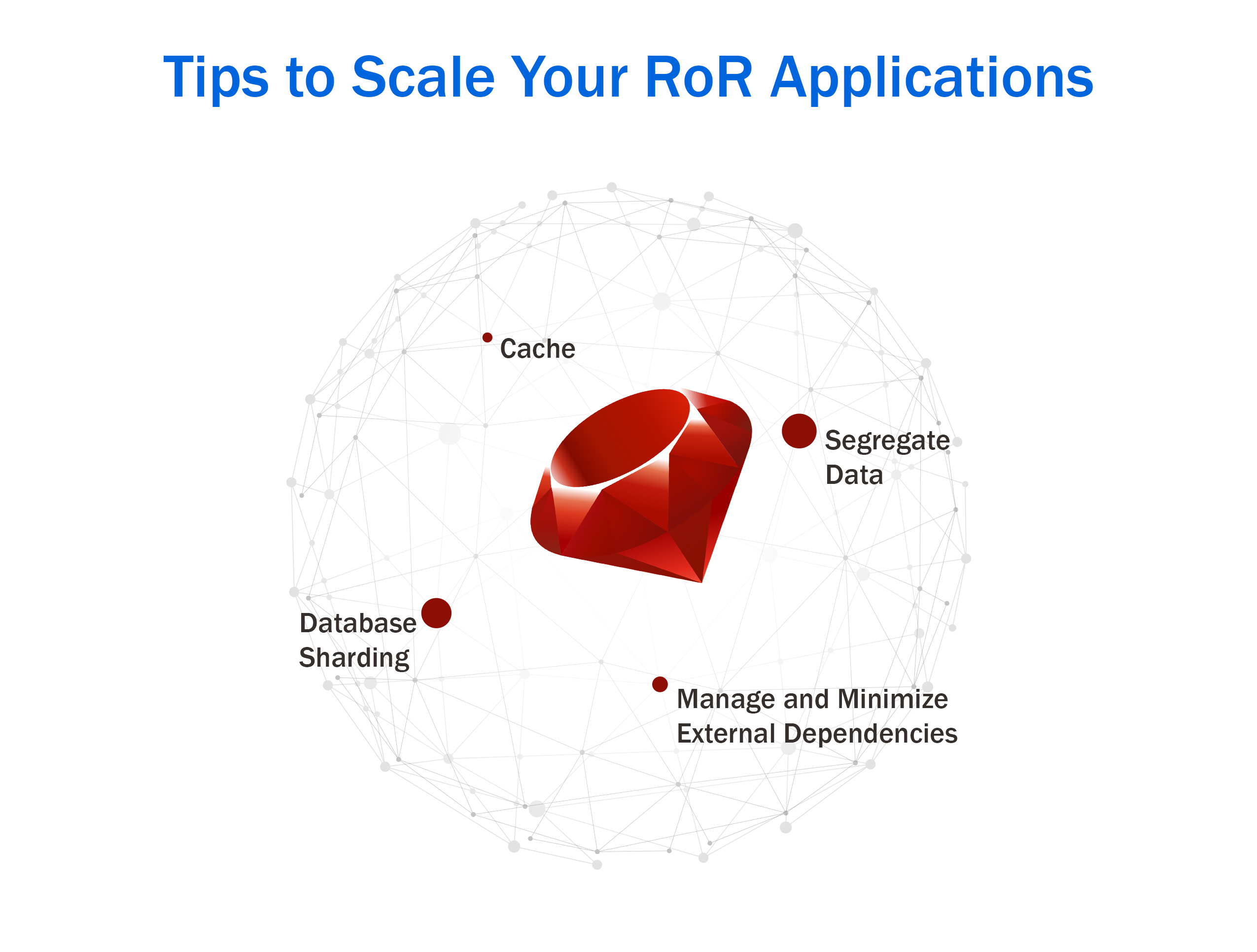Guide for Scaling Ruby on Rails Web Applications

Despite getting fully-fledged RoR application development services, web applications tend to collapse due to several factors. Scaling your application in time is an important factor contributing to your app’s success. Many companies struggle to connect with their customers (even the potential ones) when there’s a surge in requests. This results in a loss of opportunities followed by decreasing profits.
It’s common to get complaints from businesses that are based on a complex technology stack. But even for the ones working with flexible frameworks like Ruby on Rails, scalability remains a stressful concern. Therefore, we decided that it would be a great idea to present some solutions for your problems.
Why Is It Important to Scale Your Applications?
A few may consider scaling applications a secondary concern. But you must know that it can cost you your hard-earned users followed by dwindling profits. Not scaling an application on time can make it slow as traffic increases.
Your target audience won’t mind shifting their interests towards your competitors. Therefore, making them wait can be too risky as things don’t end like that. Some of these users may vent out their frustration in reviews, making it even worse!
If you consult an RoR development company, make sure to ask a few questions about how they will help you scale an application. There’s no point in ignoring major aspects related to the success of your business applications. Whether you’re a developer or a business seeking services we have some insights into scaling your apps.
Everything About Ruby Development and Scaling Issues?
Considering that Ruby is an interpreted language, it obviously uses a virtual machine to execute code. Unlike compiled languages like C++, interpreted languages are slower. However, you must not be in a hurry to jump to conclusions.
With its version 1.9.2.0, Ruby outgrew most of the issues that were affecting its scalability. However, the Global Interpreter Lock (GIL) creates one of the most common misconceptions about RoR scalability issues. GIL is a mechanism used by languages like Ruby and Python for synchronizing thread execution. It executes only one thread at a time which makes parallelism impossible.
So, where’s the misconception? An experienced RoR developer will tell you that there are ways to bypass GIL whenever necessary. This way, the interpreter can execute multiple threads together. Even if you fail to do this, no need to worry. Your application is likely to take more time for database communication than the interpreter would take to execute the code.
The major takeaway is, RoR applications are easy to scale. For proof, you can take examples of industry giants like GitHub, Airbnb, and Shopify who also use Ruby on Rails. Over the past years, the profit earned from eCommerce websites based on Shopify has only increased. Also, there were no scalability issues that caused apps or websites to crash.
Common Problems With Scaling Ruby on Rails Web Apps
We still believe that signing up for full-fledged RoR application development services will ensure the proper scaling of your apps. However, even if there are some troubles during the scaling process, we would like you to know the actual problems. Most applications can be difficult to scale when the underlying infrastructure is subpar.

Moreover, issues with scaling RoR applications may come up because of the following:
- Inefficient indexing.
- Poor database querying.
- Sluggish or improper caching.
- Choosing a subpar database engine.
- Complex codes.
- Lack of logging and monitoring.
Now, take a look at the most common problems of all.
1. Complicated Architecture
Ruby on Rails supports multi-threading. This means it can process different parts of code concurrently. Multi-threading can be seen as an advantage as it allows wiser use of CPU time and enables high-performance for apps.
However, the cost of context switching between threads can be high for complex applications. Subsequently, the performance starts lagging.
You must try to avoid making the application architecture overly complex. Ruby on Rails supports clean, reusable codes by default. When you try to customize, better keep scalability in mind.
2. Insignificant Database Setup
Many RoR developers still struggle with coding proper database indexes and checking queries for redundant requests. A complicated database index, lack of caching, and slower database queries can throw a good application off the track. Sometimes complex database indexes are nothing but a deliberate decision.
It can be an issue when you want to exchange larger records between the database and the app. Doing this without compromising on performance and user experience may require thorough research. But there are ways. You can always turn up reliable plugins to improve database performance.
3. Inadequate Server Bandwidth
This one sounds basic but is a pervasive problem in scaling Ruby applications. When there’s a lack of resources executing codes and requests becomes difficult. Certainly, cloud computing allows the provision of extra instances within a few clicks. But you still need to arrange the following:
- Any necessary apps or subsystems for extra resources.
- Costs involved with cloud computing.
Definitely, you will need some reliable tools to constantly scan your systems. It may be important to identify reasons for slow performance, under/over-provisioning resources, and overall performance benchmarks for different applications. Not having the right resources, in this case, would be like driving without a speedometer.
Tips to Scale Your RoR Applications
You will eventually find the best web application development services for your business apps. However, when it comes to creating applications specifically with Ruby on Rails, it’s better to be updated with everything that’s likely to come. Here are some tips to get through the scaling process.

1) Cache
It’s vital to use the most suitable caching methods for your apps. We suggest using Ajax libraries like JQuery for on-demand streaming of data into the browser. To cache HTTP responses use gateway proxy caches. Make sure that you know how to use tags and expiration. Leverage all the built-in actions and page caching options that come along with Rails.
2) Segregate Data
It may not be the best to store all your data in the same storage. Make sure that the independent datasets go to separate databases. Using relational database systems is always an option. However, it will be perfect to take suggestions from a Ruby on Rails development company.
Many businesses continue to use Hadoop to analyze large, unstructured data when scaling the storage. It’s always suggestible to use the main database for reporting for other data reporting requirements and not the production database.
3) Manage and Minimize External Dependencies
Take a note of dependencies on any external services like RSS feed or ad serving networks. Make sure you have an appropriate fallout strategy for any services that fail to meet your goals or cannot handle growing request loads.
4) Database Sharding
In the case of high-level scaling, database sharding becomes necessary. It involves breaking up the datasets into independent pieces according to a key. For many Rails web apps or websites sharding is done on the basis of user IDs. However, others may use data-age or access frequency for the same.
Final Takeaways
While misconceptions regarding RoR scalability prevail, seeking Ruby development services at Narola Infotech could be the best business decision. The discussion above will surely break the bubble of misunderstandings regarding RoR application scaling. Before jumping to conclusions, make sure you are not missing out on the most advantageous aspects of this framework.





